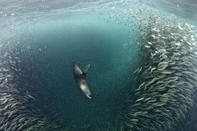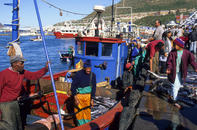Ocean Cycles
Planetary winds - fired up by the principles of convection - churn up the surface of the ocean into an ever-restless state. Now, give your globe/ball/piece of fruit a spin so that it turns from left to right, that's from west to east, so the Sun appears to rise in the east and set in the west.

The Earth's spin deflects these surface currents, to the left in the Southern Hemisphere and to the right in the Northern Hemisphere. There is then a 'drag' effect on the layer of water immediately below the surface, and the next layer down, and so on. This 'Ekman transport' effect produces a gyre or gigantic spiral of water in each hemisphere of each ocean.
Now go back to your imagined or actual globe (you may stop the spinning now) and picture how these circular gyres spin clockwise in the north and anti-clockwise in the south, both carry heat away from the equator towards their western edges and towards the colder, higher latitudes close to the poles.
Once there, they pick up a chill which they carry back down the eastern edges of their oceans. Looking at South America, southern Africa and Australia, each continent's western coastline is touched by the cold eastern reaches of the gyres that spin past them. The Benguela Current is one of the four major eastern boundary currents in the world.
Prevailing winds, associated with the South Atlantic High Pressure System and the eastward-moving cyclones at these latitudes, combine during the spring and summer months to produce a relentless south-easterly wind that blows off the continent and out to sea. This process sweeps the surface water of the ocean, warmed by the Sun, away from the coastline, causing cold waters to rush up from the ocean floor to take its place.
The ocean floor, like any self-respecting compost heap, is loaded with nutrients: everything from the carcasses of whales to fish faeces and last season's seaweed float down once their time has come and decompose on the seabed. When the washing machine action of the wind stirs the cold, bottom-level water up to the surface, it takes this thick, highly nutritious sludge with it, turning the water murky and dark.
Closer to the surface and bathed in light, marine algae or phytoplankton - the microscopic 'grasses' of the ocean's food chain - bloom spectacularly in response to this organic fertilizer. Enter the zooplankton to graze down this new growth of green. Fish and whales then feast on the zooplankton, while marine mammals and birds feed on the fish. And so the food chain bursts at the seams.
The Greatest Fisheries

This process of cold-water upwelling has created the ocean's greatest fisheries: on the Grand Banks off eastern Canada, the Georges Banks off New England, along the coast of Peru, the English West Coast, the south-western United States and, of course, off the West Coast of Southern Africa. The actual number and variety of species on the West Coast may not be as great as on the east, but the sheer volume of fish, measured in biomass, far exceeds the rest of the warmer east.
For this reason, the fishing trawlers work these western shores. Tropical waters, which are warm and relatively nutrient poor, are watery deserts by comparison with these chilly upwelling regions. Life in these waters depends on the blooming of algae. And the blooming of algae depends on the upwelling.
The upwelling depends on the wind. It's one great interconnected roundabout that turns like clockwork. But we know nature is highly unpredictable. At times, the gentle ticking of the system in cadence is overwhelmed by nature's occasional and dramatic extremes.
By Leonie Joubert